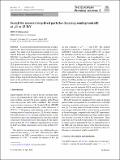Search for massive long-lived particles decaying semileptonically at $${\sqrt{s}}=13\,\hbox {TeV}$$ s = 13 TeV
Author(s)
Aaij, R.; Abdelmotteleb, A. S. W.; Beteta, C. A.; Gallego, F. J. A.; Ackernley, T.; Adeva, B.; Adinolfi, M.; Afsharnia, H.; Agapopoulou, C.; Aidala, C. A.; Aiola, S.; Ajaltouni, Z.; Akar, S.; Albrecht, J.; Alessio, F.; Alexander, M.; Albero, A. A.; Aliouche, Z.; Alkhazov, G.; Cartelle, P. A.; ... Show more Show less
Download10052_2022_Article_10186.pdf (1.108Mb)
Publisher with Creative Commons License
Publisher with Creative Commons License
Creative Commons Attribution
Terms of use
Metadata
Show full item recordAbstract
Abstract
A search is performed for massive long-lived particles (LLPs) decaying semileptonically into a muon and two quarks. Two kinds of LLP production processes were considered. In the first, a Higgs-like boson with mass from 30 to 200
$$\text {\,GeV\!/}c^2$$
\,GeV\!/
c
2
is produced by gluon fusion and decays into two LLPs. The analysis covers LLP mass values from 10
$$\text {\,GeV\!/}c^2$$
\,GeV\!/
c
2
up to about one half the Higgs-like boson mass. The second LLP production mode is directly from quark interactions, with LLP masses from 10 to 90
$$\text {\,GeV\!/}c^2$$
\,GeV\!/
c
2
. The LLP lifetimes considered range from 5 to 200 ps. This study uses LHCb data collected from proton-proton collisions at
$$\sqrt{s} = 13\text {\,TeV} $$
s
=
13
\,TeV
, corresponding to an integrated luminosity of 5.4
$$\text {\,fb} ^{-1}$$
\,fb
-
1
. No evidence of these long-lived states has been observed, and upper limits on the production cross-section times branching ratio have been set for each model considered.
Date issued
2022-04-28Department
Massachusetts Institute of Technology. Department of PhysicsPublisher
Springer Berlin Heidelberg
Citation
The European Physical Journal C. 2022 Apr 28;82(4):373
Version: Final published version